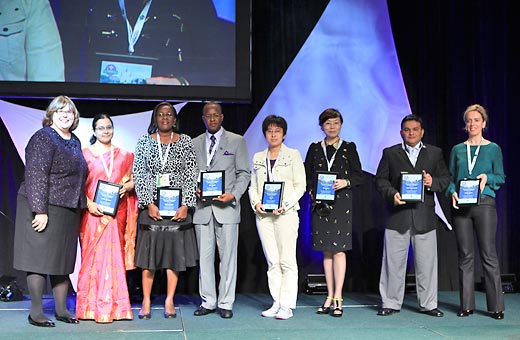AARC Congress 2012 Gazette
for Monday, November 12
Donald F. Egan Memorial Lecture
Behind a mask: tricks, pitfalls and prejudices for noninvasive ventilation
Stefano Nava MD
Editor’s Note: Stefano Nava presented the Egan Lecture yesterday morning. Here’s his recap for those who were unable to attend.

In the late 1980s, when innovators first began using noninvasive ventilation (NIV) in patients with acute respiratory failure (ARF) as a potential alternative to endotracheal intubation, few clinicians would have thought that within 20 years this technique would become a first-line intervention for some forms of ARF.
Compared with medical therapy, and in some instances with invasive mechanical ventilation, NIV improves survival and reduces complications in selected patients with ARF. The main indications are exacerbation of COPD, cardiogenic pulmonary edema, pulmonary infiltrates in immunocompromised patients, and weaning of previously intubated stable patients with COPD.
This technique can also be used in postoperative patients or those with neurological diseases, to palliate symptoms in terminally ill patients, or to help with bronchoscopy. However, further studies are needed in these situations before it can be regarded as first-line treatment.
Skill of the caregivers and the extent of their experience in the use of NIV are important to the success of this technique. Thus, as the skills of staff develop, they might be able to successfully treat very sick patients.
Optimum staffing and location for delivery depend on the acuity of the patient and the severity of the illness, monitoring capabilities of the unit, and experience of the staff. Ventilators and monitoring systems have improved and might be important in the success of NIV. Specifically, most new ventilators have modes that compensate for air leaks, improved and sometimes adjustable triggering, and systems to achieve best possible synchrony and minimize rebreathing of carbon dioxide.
Because ICUs are often full, use of this technique in other settings is becoming common in many hospitals, but patients should be selected carefully to assure safety. We expect expanded use of NIV as new applications are explored and caregivers develop skill in the technique, but caution should be exercised to restrict use to appropriate applications.
In-coming AARC president outlines goals for 2013–2014

George Gaebler MSEd RRT FAARC, was installed as the 2013–2014 AARC president during the annual business meeting yesterday morning, and he used the occasion to outline some of the goals he hopes to achieve over his 2-year term of office.
“My 3 most important goals for the next 2 years are to evaluate the transitional needs to meet the competencies necessary to develop the ‘Respiratory Therapist for 2015 and Beyond’ based on the expected needs of respiratory care patients, the profession, and the evolving health care system; continue to develop and execute strategies that will increase membership and participation in the AARC both nationally and internationally; and promote patient access to RTs as medically necessary in all care settings through appropriate vehicles at local, regional, and national venues,” says Gaebler. “These 3 goals represent the future for our profession’s growth and ability to provide the best care for our patients.”
Other goals that Gaebler will address over the next 2 years include:
- Continue to promote the patient and his/her family’s needs by being the advocate for those patients with respiratory disorders.
- Continue to advance our international respiratory community presence through activities designed to address issues affecting educational, medical, and professional trends in the global respiratory care community and to advance advocacy for the patient.
- Promote the access of high-quality continuing education to develop and enhance the skill base of current practitioners to meet the future needs of our profession.
- Maintain and expand relevant communication and alliances with key allies and organizations within our communities of interest.
- Expand efforts to obtain research funding.
- Increase and enhance activities to increase public awareness of respiratory therapists and their role in the treatment of respiratory disorders.
“I look forward to working with the AARC Board of Directors, AARC House of Delegates, the AARC Executive Office staff, and many AARC members toward the completion of my goals during my term,” says Gaebler.
International impact seen this week

The days when the profession of respiratory care was largely a North American phenomenon are rapidly coming to an end, and that was clearly evident at the meeting this week by the number of international speakers and attendees who joined us in New Orleans.
- Faten I Al-Hubaishi BSc CRT RRT-NPS came from Saudi Arabia to talk to us about tracheostomy care and Italy’s Stefano Nava MD covered noninvasive ventilation in the Egan Lecture and also presented on closed-loop LTOT.
- The Open Forum featured abstract presentations by colleagues from the United Kingdom, Taiwan, Italy, Brazil, Japan, Canada, Poland, Portugal, France, India, China, Saudi Arabia, and Australia.
- We welcomed another 7 international fellows to our meeting: Audrey Forson MB ChB FWACP MSc, Ghana; Raul Castro Garcia, Ecuador; Job Joseph MD, Haiti; Ling Liu MD, China; Manlin Liu, China; Anitha Nileshwar MD, India; and Sanihe Ugurlu MSci PT, Turkey.
This evening we’ll have the opportunity to honor an outstanding member of the international respiratory care community as we bestow the Koga Medal on Mr. Yoshihiko “Bill” Kashiwazaki during our ARCF International Reception and Fundraiser. All funds will go to support the American Respiratory Care Foundation.
And the winner is…

…the University of Maryland Medical Center! Their Vent 5K event, headed by Maria Madden BS RRT, raised over $4,500 that will be used for community and patient grants. They will be going home with a brand new ventilator donated by Breathe Technologies, Inc.
If winning a major piece of respiratory equipment sounds like something you and your colleagues would like to do too, go to www.ARCFoundation.org and click on “Vent 5K” to find out how to host your own Vent 5K in 2013. Thanks to our new partnership with FirstGiving.com, you can register your event and collect donations for your teams right online.

